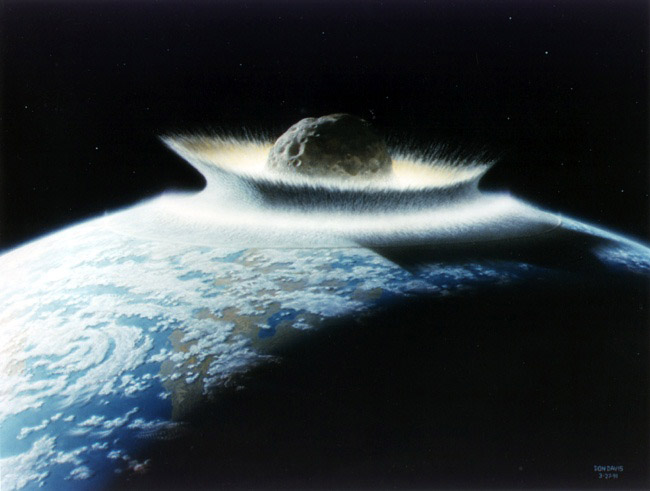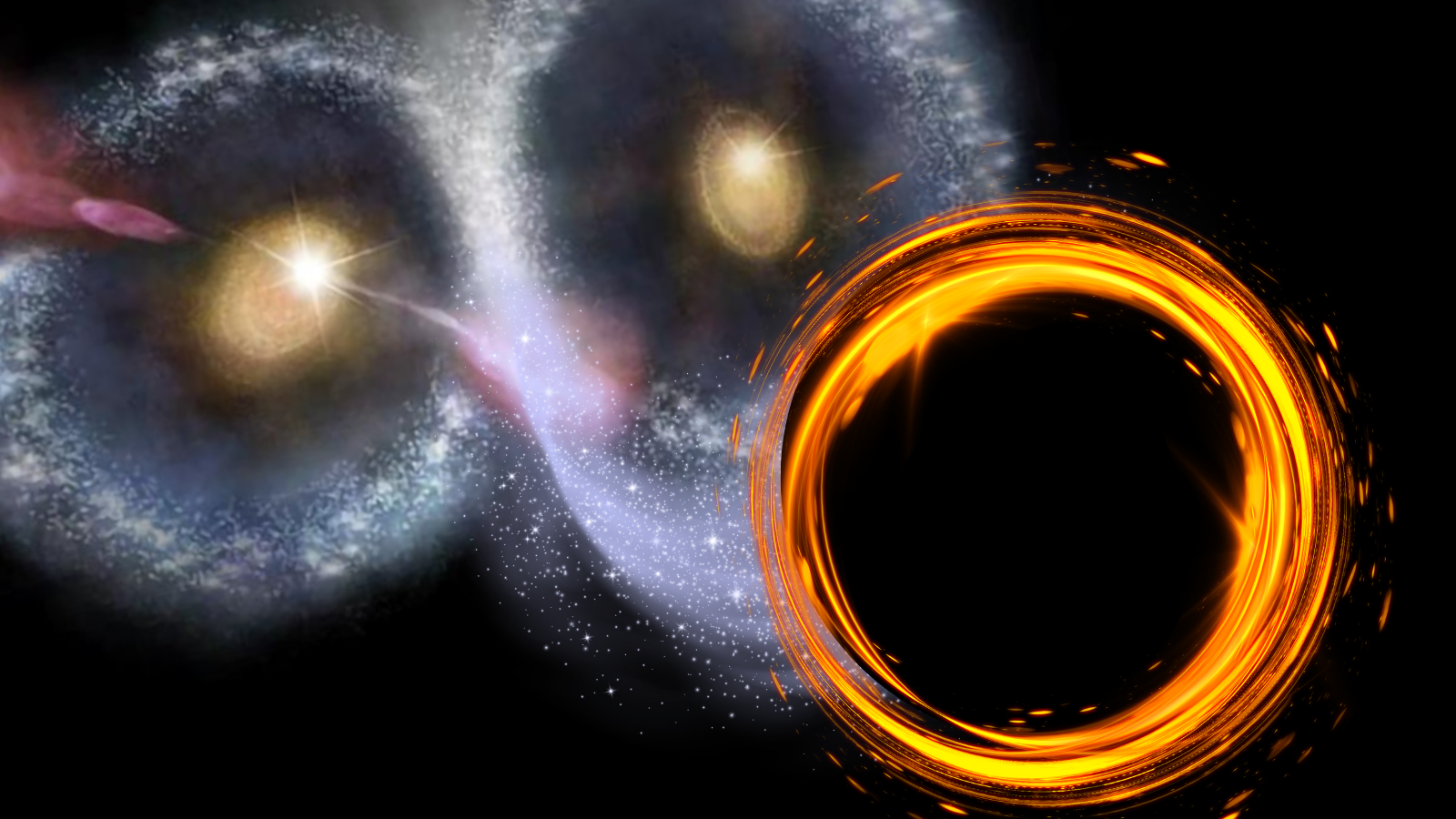Nuclear Bombs Could Save Earth from Asteroids

If a massive asteroid is hurtling toward Earth and threatening to sterilize the entire planet, blasting it to pieces with nuclear bombs might seem fit for a Hollywood movie. But, it could, in fact, be a viable solution to the potentially apocalyptic event, according to scientists who have studied asteroids and possible solutions to prevent Earth impacts.
There are some strings attached: The interloping space rock would have to pose a definite asteroid threat to Earth in a relatively short timeframe to justify such a drastic option, the scientists said. And blowing up an asteroid runs the risk of creating more debris to worry about later, they added.
If an asteroid was expected to collide with Earth within the next 50 years, using nuclear explosives to divert or disperse the hostile space rock could be the best alternative, explained David Dearborn, a research physicist at the Lawrence Livermore National Laboratory in Livermore, Calif.
"The nuclear bomb is the strongest bomb we know," said Dearborn, who presented his study last month at the 216th meeting of the American Astronomical Society in Miami, Fl. "It's about 3 million times more efficient than chemical bombs. The question is how to use that energy."
The Lawrence Livermore National Laboratory, a research facility founded by the University of California, has programs that design and test nuclear weapons. [Top 10 Weapons in History]
Nuclear bangs in space
Dearborn believes that powerful nuclear explosives could be used to change the orbit of an asteroid heading for Earth, causing it to miss our planet and avoid a potentially devastating impact.
Breaking space news, the latest updates on rocket launches, skywatching events and more!
But, that nuclear option is most effective in circumstances where there are only a few years notice, said David Morrison, director of the NASA Lunar Science Institute and senior scientist for Astrobiology at NASA's Ames Research Center at Moffett Field, Calif., who has done extensive research on asteroid and comet impact hazards.
"If we have an asteroid that is really large, and we don't have more than a few years notice, nuclear is probably all we can do," Morrison told SPACE.com. "If it's a mile or smaller and we have 10 to 20 years warning, we probably won't go nuclear."
In such cases, scientists could opt to impact the asteroid with a ballistic rocket, sending the cosmic interloper off course.
At the moment, there is probably very little difference in terms of accuracy for both the nuclear method and ballistic method, said Morrison. But if using ballistic rockets to divert asteroids can be tested, it is possible that this technique could be more precise.
"If we test the ballistic impact, as people have proposed doing, then we can make it much more accurate than a nuke," he said.
But will it really work?
In fact, the ability to test these methods is one of the main sources of contention.
"One of the problems with the nuclear alternative is that I don't think anyone will ever let us test it," Morrison explained. "I think it would arouse considerable opposition from the public, because people are very nuclear averse. That's the thing about David Dearborn and I ? we don't disagree about the facts at all. I'm just a little less anxious to embed the public relations problem."
Some of the issues that have affected previous ideas on how to divert asteroids have been due to the extremely low levels of gravity present on asteroids.
"If you were to watch an asteroid go by in space, it would look like a tumbling dog bone," Dearborn said. "On a one kilometer (0.62 mile) asteroid, a 200-pound person would weigh about 1/10th of an ounce. So, proposals that people have made for how to divert them have encountered problems with how you give a push to an asteroid."
NASA is now aiming to send astronauts to visit an asteroid by 2025 to get a first-hand look at them. The mission is part of the space agency's new space exploration plan proposed by President Barack Obama.
Additionally, a European spacecraft, Rosetta, will be gliding past asteroid Lutetia on July 10 to get some close-up views of the space rock. Scientists are hoping that the observations from the flyby will contribute to the relatively small body of knowledge about asteroids.
Blowing up asteroids
According to Dearborn, blowing up an asteroid ? or fragmenting it ? using powerful nuclear explosives could be the most effective way of diverting it.
For one, nuclear fusion is vastly more efficient per unit of mass, compared to chemical fuel. So, from a practicality standpoint, it would be easier to transport this type of energy into deep space for an asteroid-diverting mission.
"You can carry an awful lot of energy for a very small amount of mass," Dearborn said. "As long as payload ? the ability to lift things and get them to deep space ? is significant, this is a way of transporting enough energy to do the job."
The sheer power of nuclear explosives also makes it a good candidate for such a task.
Dearborn discussed a previous proposal to use a powerful laser beam to repeatedly zap an asteroid in order to alter its course. While this could be a feasible option, Dearborn said, the timescale needed to carry out such an operation using current technology is too large.
For example, using a beam from the National Ignition Facility to deliver enough energy would require 5 million pulses which would have to be delivered over the course of approximately 6,000 years.
To effectively fragment and divert an asteroid, its orbit must be pushed by at least a centimeter per second. To do this, about five to 10 kilotons of energy input is needed, regardless of the method.
"The nice thing about any kind of intervention is that you only have to make it miss the Earth," Dearborn said. "A very small change in its orbital period will do that."
But wait, there's more
Still, the problem does not end with simply blowing up an asteroid.
Fragmenting an asteroid creates a debris field, and it is important to account for these remains in such a way that only a fraction of the debris is able to pass through the Earth's atmosphere.
Dearborn created simulations to examine the amount of energy and time needed to most effectively divert an asteroid and disperse its debris field in such a way as to minimize collisions with Earth.
He found that intersecting a 270-meter body asteroid with a 300 kiloton energy source at the surface could safely be done 15 days out from impact.
"If you can intersect it 15 days out, which is beyond the orbit of the moon, that would be fine," Dearborn said. "It was enough that 97 percent of that material missed Earth."
Furthermore, if the explosion occurs far enough into space, debris should be less of a concern, said Morrison.
"If you're going to do this 100 million miles away from Earth, it shouldn't be too much of a problem," Morrison said. "There'll be a little bit of debris, but by the time it gets close to us, it would be pretty dispersed."
Asteroid sentinels on alert
Dearborn is continuing to experiment with models and simulations that attempt to determine the amount of time needed to act for different size asteroids.
And while Dearborn states that a truly disastrous impact with Earth is possible, the chances of such an occurrence remain slim.
"There will be another large impact resulting in global catastrophe any mega-year now," he said. "But, a million years is a really long time."
The Spaceguard Survey Report from NASA's Ames Space Science Division, which was an effort to study near-Earth objects, has done extremely well in locating large objects that could cause mass extinction.
"We've found more than 90 percent of those," Morrison said. "In a few more years, we'll be able to say that there's nothing out there to cause a global catastrophe. But, there'll be a million that will be big enough to wipe out an entire city. It'll take a long time, if ever, to find them and figure out their orbits."
Technological advancements in ground-based and space telescopes should assist scientists in their study of near-Earth objects and other potential hazards, but the threat will likely be omnipresent, since smaller objects will always be more difficult to track down.?
"The bottom line is, we could be hit by one of those small ones at any time, with no warning at all," Morrison said. "Right now, I can say almost nothing about the probability of one of those small objects hitting us, because we simply haven't found all of them."
Still, in the event that an asteroid crashes toward Earth, particularly with only a few years warning, nuclear explosives may be our best option, both scientists agree.
"With current technology and enough time, we should be able to divert large bodies," Dearborn said. "Right now, it is the only technology that we have that has the energy to move large bodies.
- Images - Asteroids Up Close, Astronauts on Asteroids
- NASA's New Asteroid Mission Could Save the Planet
- Will an Asteroid Hit Earth? Are We All Doomed?

Denise Chow is a former Space.com staff writer who then worked as assistant managing editor at Live Science before moving to NBC News as a science reporter, where she focuses on general science and climate change. She spent two years with Space.com, writing about rocket launches and covering NASA's final three space shuttle missions, before joining the Live Science team in 2013. A Canadian transplant, Denise has a bachelor's degree from the University of Toronto, and a master's degree in journalism from New York University. At NBC News, Denise covers general science and climate change.
